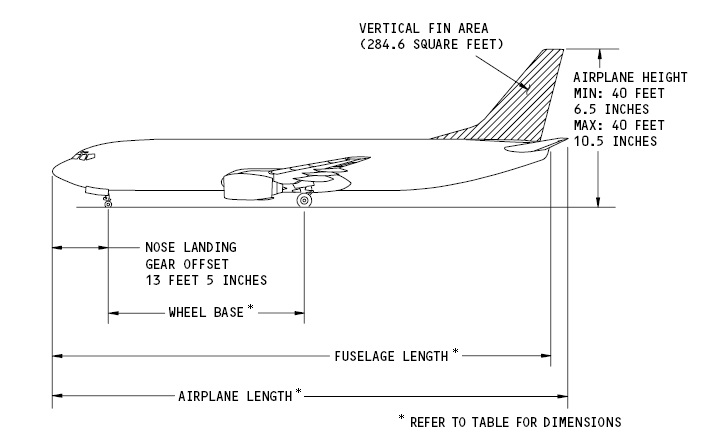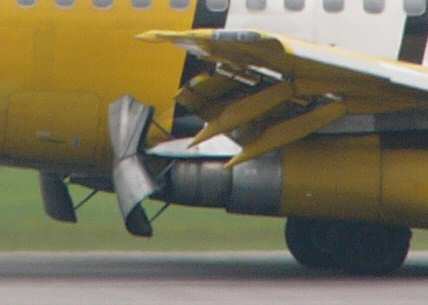RUDDER SYSTEM
Yaw control is achieved by a single graphite / composite rudder panel. A single rudder power control unit (PCU) controls rudder panel deflection. A standby rudder PCU provides back up in the event of malfunction of the main rudder PCU. There is no manual reversion for yaw control. The only internal indication of rudder panel deflection is pedal position, which always accurately reflects control surface deflection. Total authority of the control surface is modulated in relation to aircraft IAS using “blowdown”, ie a constant pressure is applied to the surface by the actuator, and the movement of the panel reduces accordingly as the dynamic pressure on it increases. For this reason maximum rudder pedal movement is reduced with increasing airspeed. Maximum rudder panel deflection is approximately +/-15 degrees on the ground, reducing to around +/-8 degrees at a typical cruise altitude.
Power Control Unit (PCU)
The rudder PCU consists of an input shaft / crank mechanism, a dual concentric servo valve to control porting of the fluid to the rudder actuator, and a yaw damper actuator. The rudder actuator is a tandem actuator, having two internal piston areas for each hydraulic source (A & B). The actuator is capable of positioning the rudder panel with either one or both main hydraulic sources available, though with one source inoperative a reduced rudder panel deflection would result due to blowdown at higher airspeeds.
Flow of hydraulic fluid to the rudder actuator is controlled by the dual servo-valve. This is a complex dual concentric cylinder with an outer and inner slide. During normal rudder pedal inputs sufficient rudder panel deflection is catered for by the primary (inner) valve alone. However, should a larger panel deflection be required or a higher rate rudder input be commanded, the secondary (outer) sleeve moves in addition to port extra fluid to the actuator. Movement of the outer sleeve is typically no more than 1mm. Position of both sleeves of the servo valve is controlled by a complex mechanism of bell cranks, input rod and summing lever, the geometry of which is such as to provide movement of the sleeves in relation to the body of the valve.
The 737NG also has a standby rudder PCU that moves the rudder during manual reversion operation. The wheel-torudder interconnect system (WTRIS) will coordinate (assist) turns by using the standby rudder PCU to apply rudder as necessary based upon the Captains control wheel roll inputs. From experience, I can verify that this makes the NG much easier to handle in manual reversion than previous generations.
YAW DAMPER
The yaw damper is incorporated to prevent Dutch roll. It is connected in parallel with the main servo valve and includes its own actuator, powered by hydraulic system B. This actuator applies its own input to the input shaft / crank mechanism to bring about a movement of the servo-valve and hence a rudder panel deflection. No pedal movement results from yaw damper operation. Total authority of the yaw damper is approximately +/-2.5 degrees.
NGs: The 737-NGs also have a standby yaw damper; it uses the standby rudder PCU, with commands from SMYD 2 and powered by the standby hydraulic system. SMYD 1 controls the main yaw damper with hydraulic system B. Note: Only inputs from the main yaw damper are shown on the yaw damper indicator.
Rudder Pressure Reducer (RPR) - 3/4/500
To limit the effects of various PCU failure modes (pre-RSEP), a rudder pressure reducer (RPR) was fitted to the Asystem pressure side of the rudder PCU. This is simply a pressure reducing valve, which operates during the majority of flight phases to reduce the total authority of the rudder panel by approximately one-third. The B-system portion of the rudder PCU is unaffected by the RPR, as is yaw damper operation
During certain critical phases of flight when full rudder authority may be required, the RPR provides full system pressure (3000psi from 1800psi) to the rudder PCU. These are: -
a) During take-off below 1000’ Rad.alt.
b) During approach below 700’ Rad.alt.
c) If a difference of >45% N1 exists between power units.
d) If B-system hydraulic pressure is lost.
Whilst correct functioning of the RPR is transparent to the flight crew, certain cockpit indications can be helpful in verifying correct operation and faults alike; the A system flight controls low pressure warning light now has two additional functions related purely to the RPR; on initial application of pressure to hydraulic system A, the lowpressure warning light should remain illuminated for 5 seconds. If the light extinguishes immediately then a fault may be present within the RPR. Incorrect mode switching of the RPR is also indicated by illumination of the light on approach below 700ft RA, indicating that full pressure is not available to the A-system portion of the rudder PCU. A further associated failure of hydraulic system B and an asymmetric thrust condition may result in insufficient rudder authority to maintain directional control
Digital Yaw Damper Coupler
The yaw damper coupler comprises the control electronics and yaw rate gyro. A digital yaw damper coupler helps reduce the possibility of electro-magnetic interference (EMI). Turn co-ordination is provided by reducing the gain of the yaw-rate gyro in proportion to bank angle detected from the IRU. In this way during a turn the yaw damper coupler is “tricked” into believing the aircraft is yawing into the turn and provides an increased rudder input. The coupler is sensitive only to yaw rates that produce Dutch Roll. Note that the yaw damper coupler controls and monitors both the RPR (Sys A) and RPL (Sys B) of the main rudder PCU, a de-activated yaw damper also renders the RPR & RPL inoperative. For this reason higher block manoeuvring speeds are used when the yaw damper is u/s (not NGs).
Rudder System Enhancement Program (RSEP)
The Rudder System Enhancement Program (RSEP) introduced in 2003 (SB 737-27-1252/3/5) must be implemented on all series of 737s by 12 Nov 2008. It replaces the infamous dual concentric servo valve with separate input rods, control valves and actuators; one set for hydraulic system A, and one set for hydraulic system B. The standby PCU is controlled by a separate input rod and control valve powered by the standby hydraulic system. All three input rods have individual jam override mechanisms that allow inputs to be transferred to the remaining free rods if a jam occurs. All 737s must be fitted with the RSEP by Nov 2008. Modified aircraft are identifiable by the STBY RUD ON light on the flight controls panel and new c/bs on the P6-2 panel labelled “Force Fight Monitor” (all series) and “Rudder Load Limiter” (not NGs).
Force Fight Monitor (FFM)
The main rudder PCU contains a Force Fight Monitor (FFM) that detects opposing pressure (force fight) between A & B actuators, this may happen if either hydraulic system, input rod or control valve has jammed or failed. If this condition is detected for more than 5 seconds, the FFM will automatically turn on the standby hydraulic pump pressurising the standby rudder PCU. This will also illuminate the new STBY RUD ON light on the flight control panel
Rudder Pressure Limiter (Not NGs)
This is effectively the B system equivalent of the RPR, except that it is physically part of the main rudder PCU rather than upstream of it. Hydraulic system B pressure is reduced within the main PCU from 3000 to 2200psi it has the same activation criteria as the RPR
NGs
The NGs do not have an RPR or RPL, but two Load Limiters instead (Shown as “CONTROL VALVE”s in the FCOM schematics). At speeds above approximately 135kts, hydraulic system A pressure (Pre-RSEP), hydraulic system A and B pressure (Post-RSEP) to the rudder PCU is reduced to 1450psi (Pre-RSEP) / 2200psi (Post-RSEP). They both reduce rudder output force by 25% at blowdown speed. The NGs also gained the FFM and separate input rods, control valves and actuators of the RSEP package.
Analysis of QRH Procedures
The QRH procedures for rudder malfunctions were first introduced in January 1997. Since then they have changed several times, either to simplify the procedures or as a result of hardware changes. They still have many branches depending upon the RSEP status of the aircraft and what condition is detected by the crew.
An uncommanded rudder deflection and/or hardover may be caused by a number of different failure modes within the rudder PCU and/or yaw damper, and the severity of symptoms could differ widely from a nuisance yaw damper deflection to a full-scale rudder hardover resulting in reduced controllability. As identification of the primary cause of such a failure may be impossible in flight, certain procedures have been mandated which aim to minimize the effects of the malfunction. There are two similar QRH drills which cover this situation:
JAMMED OR RESTRICTED FLIGHT CONTROLS
Condition: Movement of the elevator, aileron/spoiler or rudder is restricted
UNCOMMANDED RUDDER/YAW OR ROLL
Condition: Uncommanded rudder pedal displacement or pedal kicks or uncommanded yaw or roll.
The latter is more appropriate for a rudder hardover, but either procedure will direct you to the correct solution.
AUTOPILOT (if engaged)…………………..DISENGAGE
AUTOTHROTTLE (if engaged)……………DISENGAGE
Verify thrust is symmetrical.
These are the only recall items. First disengage the automatics, get control of the flight path and verify thrust is symmetrical. If you have a STBY RUD ON light installed (and serviceable), ie an RSEP a/c, then go to the JAMMED OR RESTRICTED FLIGHT CONTROLS checklist. The logic here is that the FFM will either have detected an opposing pressure between A & B actuators and activated the standby rudder PCU or there was no opposing pressure and the problem was a jam rather than a hydraulic problem.
The rest of this section assumes that you do not have a STBY RUD ON light installed (ie Pre-RSEP a/c).
YAW DAMPER……………………………..OFF
The yaw damper is switched OFF. This removes power to the yaw damper actuator, therefore eliminating any input to the main rudder PCU. Whilst this should eliminate any nuisance yaw and secondary roll caused by a failure within the yaw damper or coupler, with its limited authority over main rudder panel deflection it is highly questionable whether this alone could produce a large-scale uncommanded rudder movement.
If the yaw or roll is the result of uncommanded rudder displacement or pedal kicks:
Rudder trim………………………………….Center
Rudder pedals………………………………..Free & center
After verifying zero rudder trim, the checklist calls for a maximum combined effort of both pilots to centre the rudder pedals. The intention of this is to provide a maximum force to shear any metal fragments or “chips” which may be present within the servo-valve. Remember, centred pedals mean a centralised rudder.
If rudder pedal position and/or movement are not normal:
SYSTEM B FLIGHT CONTROL switch….STBY RUD
During a normal flight phase, the rudder has three separate sources of power; A-system hydraulics, B-system hydraulics and Standby hydraulics. The objective of any such drill would be to reduce the uncommanded deflection of the rudder panel, and to restore some directional controllability. This is achieved within the drill by first reducing the authority of the main rudder PCU by removing the B-system hydraulic source. A-system pressure remains, but at a considerably reduced pressure due to the functioning of the RPR / load limiter, hence blowdown will help to realign the control surface. Re-positioning the B-system flight controls switch to standby rudder removes B-system hydraulic pressure from the main rudder PCU, and provides a completely independent method of rudder panel control through the standby rudder PCU, further assisting in re-alignment of the control surface.









































